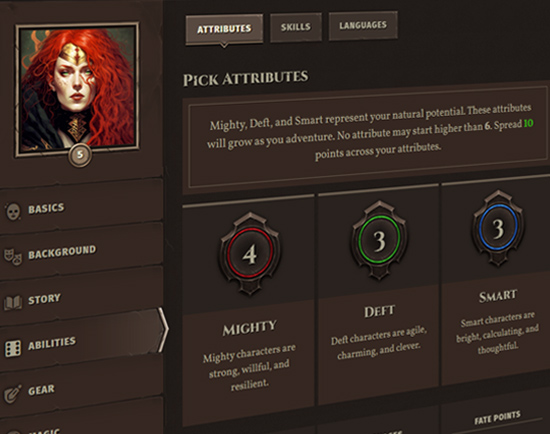Stances are advanced abilities you learn when you level up. Every level, you learn a new stance.
A stance is an opportunity to refine your character concept by making it easier to do the things you already do as an adventurer. For example, if you're playing the Rogue class, you might decide to learn the Expert Disguise stance, so that you can do a better job at creating disguises:
Expert Disguise
As a master of disguise, you adopt identities with near-perfect fidelity. Your unique skill makes it possible to replicate a specific person. As an action, you may appear thin or fat, short or tall, and any origin or form similar in size and shape to your own. You must expend a cheap supply to create the disguise, and if you are replicating a specific person, have prior knowledge of their appearance and general demeanor. If the GM requires a check to create the disguise, you may re-roll it if you fail.
As you can see, the Expert Disguise stance lets you expend a cheap supply to create a disguise that is a near perfect impersonation of a specific person without a need to roll. Ordinarily, this might require a number of checks and/or significant legwork to pull off in the fiction. But the stance accelerates all that so you can get right to the fun of impersonating your mark.
Using Stances
A stance is a type of free action that you activate when you do something in the fiction. In encounter mode, most stances function as reactions or bonus actions, but some stances are actions unto themselves. The stance will always specify how it can be used in conjunction with an action you take in its description; if it does not, then it can be used as a bonus action on your turn in the round, or it happens at the same time as the action you take described in the stance.
Types of Stances
There are two types of stances in the game: active and passive.
Active Stances
Active stances take a lot out of you to use. You can use an active stance once, then you have to rest before using it again. Consider the Shockwave stance:
Shockwave
You make your fearsome presence known as a mighty shockwave that reverberates throughout the battlefield. When you leap into the fray or slam your weapon on the ground, all those in a melee space surrounding you must make contested Mighty check at disadvantage or be knocked prone.
You must declare that you're using a stance in order to benefit from it, and you can't use a stance after you've rolled for it, or the GM has described the outcome of your action.
Passive Stances
You can use a passive stance as many times as you wish, as long as you've slotted it as your focus. A focus represents your current adventuring mindset or physical positioning in the encounter. You can only ever have a single stance slotted as your focus at a given time.
Although passive stances are always available to you to use, you must declare that you want to take advantage of your stance in order to benefit from it, and you can't use a passive stance after the GM has described the outcome of your action.
Switching Focus
Outside of resting, you can spend 1 MP to switch your focus once at the start of the round. Switching focus is not considered an action, and you can switch your focus even if you're not able to act in the round. You must declare that you're switching your focus to the GM, as it may be apparent in the fiction that you're switching stances to your opponents. (For example, if you take a Fortified Stance, you're probably raising up your shield to defend yourself, which indicates to opponents that you'll be harder to engage with.)
Some other rules regarding your focus:
- Only passive stances can be slotted as your focus.
- You can opt to switch your focus all the way up until before it's your turn to act.
 Archetypes
Archetypes Armor
Armor Classes
Classes Conflicts
Conflicts Cultures
Cultures Ethos
Ethos Flaws
Flaws Glossary
Glossary Kits
Kits Maleficence
Maleficence Origins
Origins Shields
Shields Skills
Skills Spells
Spells Stances
Stances Status Effects
Status Effects Tactics
Tactics Talents
Talents Techniques
Techniques Treasure
Treasure Weapons
Weapons











 Hall of Heroes
Hall of Heroes Hall of Legends
Hall of Legends



 Dungeons & Flagons
Dungeons & Flagons